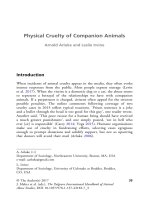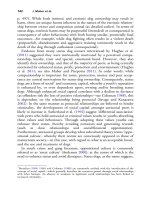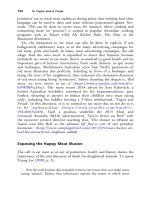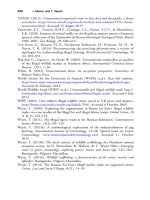The palgrave international handbook of a 279
Bạn đang xem bản rút gọn của tài liệu. Xem và tải ngay bản đầy đủ của tài liệu tại đây (38.53 KB, 1 trang )
276
K. Young
introduced solely to titillate audiences and enhance economic value.
Promotion of the chucks heavily underscores the bravado, adrenaline and
risk imbued in all rodeo events (Mikklesen 2008; van Herk 2008) and is
amply demonstrated by the way the Stampede’s own website publicizes itself
in unambiguously spectacular ways: ‘You’ll witness all the heart-stopping
action as 36 drivers, 216 horses and the teams vie for over $1.15 million in
prize money.’
The principal controversy underlying much of the debate surrounding
the chuckwagon racing relates to the prevalence of (often gruesome)
injuries and fatalities that occur as a direct result of racing. Countering
its success as a hugely popular attraction (thousands of spectators pour
into the Stampede grounds every night) and the undeniably popular
view that ‘the chucks’ are exciting to watch, is the Stampede’s equally
undeniable—and clearly discouraging—report card where animal safety
is concerned.
Reliable statistics on horse racing accidents, injuries and deaths at the
Stampede are both difficult to find and rationalized at every turn. To
provide some depth to the question of the prevalence of horse injuries
and deaths, there are, of course, innumerable news articles posted online
describing individual cases of horse injuries and deaths, as well as social
responses to such cases raising critical questions about the legitimacy,
responsibility, and viability of such obviously high-risk ‘sports’ (for both
human and animal participants) (for example, CBC News 2010; CBC
News 2012). While news of such individual cases is not hard to find,
locating reliable quantitative data on horse deaths at the Calgary
Stampede, related either to chuckwagon racing or the cluster of other
equine activities that the Stampede sanctions, is a different matter altogether. Certainly, sites and lists exist (for example, Global News 2012; Ban
Chuckwagon Racing 2013; Vancouver Humane Society 2010), but their
reliability is again debatable. In all cases, it is not difficult to see that such
lists are posted by groups with interests to defend and ideological positions
to advance. Similarly, several organizations beyond Calgary and indeed
Canada maintain and publish records of equine injuries and fatalities in
the form of ‘data bases’ in racing sports. Within Canada, for instance,
Woodbine Racetrack in Ontario, fully accredited by the National
Thoroughbred Racing Association, posts current and past archives (e.g.,
Woodbine Entertainment 2010). Beyond Canada, the British Horseracing
Authority, for example, regularly updates racetrack reports (for example,
British Horseracing Authority 2014). And finally, organizations such as
Animal Aid maintain and release a ‘Race Horse Death watch’ (Animal Aid









